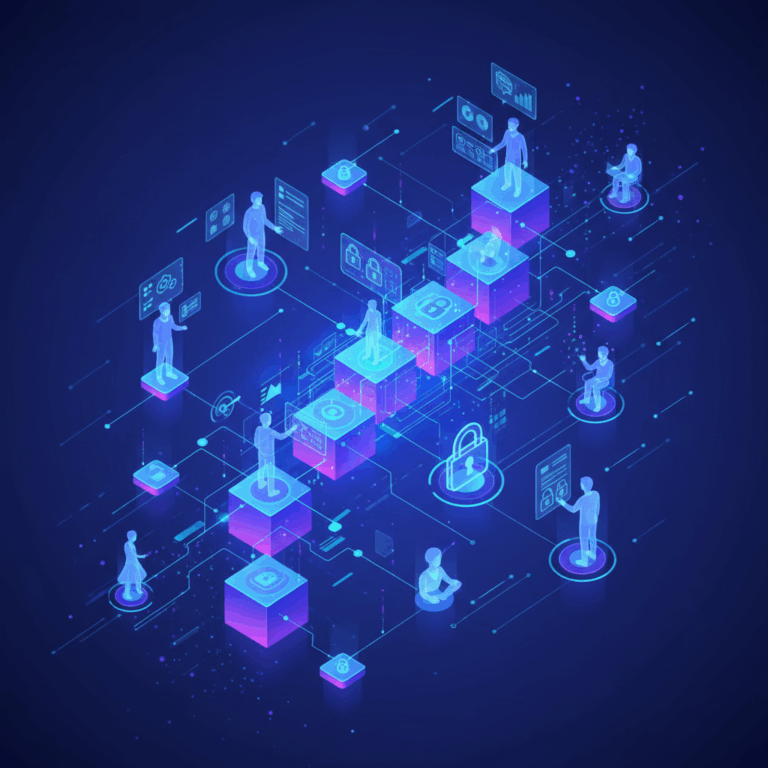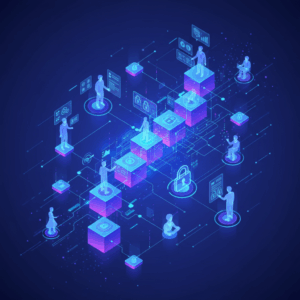Fundamentals of Web3 Technology
Web3 technology represents a transformative shift toward a decentralized internet where users regain control of their data. It aims to replace centralized models with distributed networks.
At the core of Web3 is the principle of user empowerment, allowing individuals to own and manage digital assets independently. This transforms online interactions, making them more secure and transparent.
With Web3, users engage directly without intermediaries, creating a more open and user-centric ecosystem. This fundamental change addresses many concerns linked to data privacy and control in today’s web.
Decentralization and User Control
Decentralization in Web3 removes the dominance of large corporations over data and services. Instead, power is distributed among users, fostering a fairer internet environment where control is returned to individuals.
User control means that individuals manage their digital identities, content, and assets without relying on central authorities. This reduces censorship risks and enhances personal privacy significantly.
By enabling peer-to-peer interactions, Web3 encourages a direct relationship between users and services, minimizing intermediaries. This model strengthens autonomy and trust within digital communities.
Blockchain as the Backbone of Web3
Blockchain technology is the fundamental infrastructure supporting Web3, offering a transparent and secure ledger to record transactions and ownership. It ensures data integrity and trustworthiness without needing central oversight.
This ledger system supports decentralized applications and smart contracts, allowing users to transact and interact in programmable and trustless ways. Blockchain enables digital scarcity and proven ownership of assets.
Because blockchains are tamper-resistant, they provide a reliable framework for digital identities, asset management, and community governance, essential for Web3’s decentralized vision.
Core Components and Innovations in Web3
Web3 introduces core elements that innovate how users engage with online services. Decentralized applications and governance models reshape the internet’s landscape.
This ecosystem is enriched by decentralized finance and NFTs, which enable new economic opportunities. Also, user ownership of digital identities and assets becomes a central feature.
These innovations collectively empower users, promoting transparency, security, and autonomy in digital interactions.
Decentralized Applications and DAOs
Decentralized applications, or dApps, run on blockchain networks, removing intermediaries and enabling peer-to-peer interactions. They provide services from finance to social networking without centralized control.
DAOs, or decentralized autonomous organizations, represent a new way to govern communities. They use smart contracts for decision-making, where members vote transparently on proposals.
By combining dApps and DAOs, Web3 fosters collaborative environments where users have real influence over protocols, enhancing trust and participation.
Interesting Fact About DAOs
DAOs have been used for funding projects, managing communities, and even running investment clubs, demonstrating their wide potential beyond traditional organizations.
Decentralized Finance (DeFi) and NFTs
DeFi leverages blockchain to offer financial services like lending, trading, and insurance without traditional banks. This opens finance to anyone with internet access.
NFTs, or non-fungible tokens, represent unique digital assets verified on a blockchain. They enable creators to prove ownership of art, music, and collectibles in a way never possible before.
Together, DeFi and NFTs create new models for value exchange, ownership, and monetization, driving innovation in digital economies.
Ownership of Digital Identities and Assets
Web3 empowers users with control over their digital identities, stored securely on blockchain networks without reliance on central authorities. This reduces identity theft and censorship risks.
Ownership of assets also shifts to the individual, as blockchain enables verified and immutable proof of possession. This includes digital art, tokens, and even virtual real estate.
Such control builds a more transparent digital world where users decide how their information and property are used and shared.
Privacy and Security Enhancements
Web3 enhances privacy by minimizing dependence on centralized entities that traditionally control user data. This shift empowers individuals with greater control over their information.
Security improvements stem from blockchain’s immutable and transparent nature, making data tampering and unauthorized changes extremely difficult without consensus.
These advances collectively foster a safer and more private online environment, supporting Web3’s vision of user autonomy and data sovereignty.
Reducing Reliance on Centralized Authorities
Web3 technologies reduce dependence on central authorities by enabling peer-to-peer interactions secured by blockchain protocols. This model limits single points of failure or control over data.
Decentralization means fewer opportunities for censorship, data breaches, or misuse by large corporations. Users keep custody of their information without intermediaries.
By distributing data storage and decision-making, Web3 creates a more resilient system that resists centralized manipulation and increases users’ confidence in the network.
Improving Trust and Autonomy Online
Web3 builds trust through transparency, as all transactions and data modifications are recorded on public ledgers accessible to everyone. This openness reduces hidden risks and fraud.
Users gain autonomy by controlling their digital identities and assets without needing permission from centralized platforms. This independence encourages freer and more secure participation.
Smart contracts automate agreements, ensuring that trust does not rely on any single party but is embedded in code, reducing disputes and enhancing reliability across digital interactions.
Future Potential and Challenges
Web3 holds transformative potential to revolutionize the internet by enhancing user ownership and decentralization. However, it faces significant obstacles before wide adoption.
The future of Web3 depends on overcoming regulatory uncertainties and improving the technology’s ability to scale efficiently. These challenges are critical for its growth.
Educating users about Web3 and making technology accessible will be essential in realizing a decentralized, user-driven web that is secure and trustworthy.
Regulatory and Scalability Issues
Regulatory uncertainty is a major challenge for Web3, as governments worldwide are still defining how to oversee decentralized systems and digital assets. This creates risks for developers and users.
Scalability issues also limit Web3’s current capacity to handle large volumes of transactions efficiently. Network congestion can lead to high fees and slow processing times.
Addressing these scalability challenges requires advances in blockchain protocols and layer-two solutions to enable mass adoption without compromising decentralization.
Adoption and Technological Literacy
Widespread Web3 adoption depends on increasing user understanding of decentralized concepts and ease of access to tools like wallets and dApps. Many users find current interfaces complex.
Improving technological literacy will empower more people to participate actively in Web3 ecosystems, promoting greater inclusivity and democratization of online services.
Educational efforts and user-friendly designs are critical to lowering barriers and accelerating the transition toward a decentralized web.






